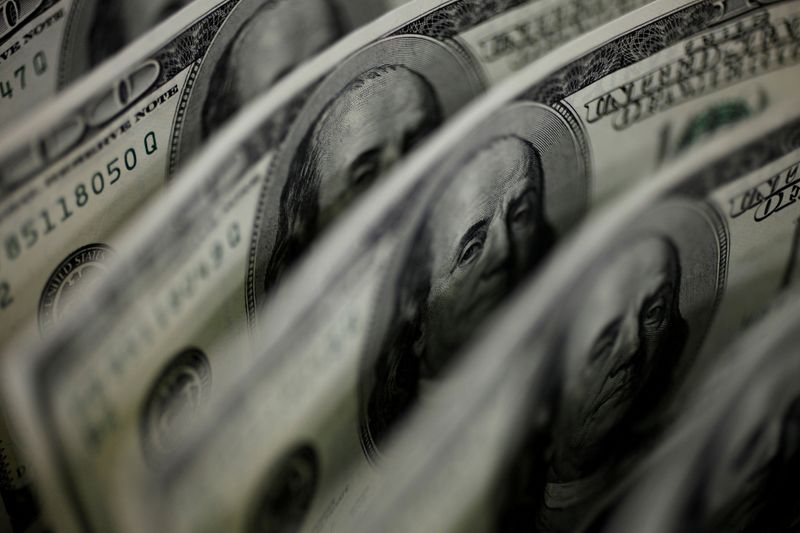LONDON (Reuters) – An unexpected dollar bounce and some indications of a broader resurgence are confounding market players who took bearish positions on the U.S. currency on a bet that it was headed for a multi-year downtrend.
Given the volume of global investment and commercial trade flows that hinge on dollar strength or weakness, getting the exchange rate correct is one of the most crucial calls a fund manager can make.
According to one fund manager, the dollar could be about to complete a trading pattern known as the “Dollar Smile,” which has in previous years preceded major U.S. economic rebounds and currency surges.
Put forward by Stephen Jen, who runs hedge fund Eurizon SLJ Capital, it holds that the greenback strengthens in tough times as investors rush for safe, liquid assets.
The currency then falls as U.S. growth flags, forcing Federal Reserve rate cuts that lead the dollar lower- the bottom of the smile – before rising again as the U.S. economy leads the global growth rebound.
Per that theory, the dollar’s 40% appreciation between 2012 and February 2020 would have been the final upward stage of the smile following the troughs of 2011-2012.
In the current cycle, Jen reckons the first two stages of the smile formation are complete: the dollar index shot to a 3-year high in March 2020, when investors sought it out amid the pandemic-linked market mayhem.
It then declined when the Fed slashed interest rates to 0%, hitting a near three-year low last month on expectations of ultra-easy U.S. policy and additional borrowing that would blow out the balance of payments deficit.
In the past month, however, the greenback has jumped by more than 2%, as a fast vaccination campaign appears to signal that the world’s biggest economy will recover more quickly from the COVID-19 doldrums than most other developed nations.
“My point has been that the U.S. would come out of the pandemic very strong,” Jen said. “That is being demonstrated very clearly.”
He predicts the last part of the Smile to complete when the euro falls to $1.13, a level unseen since last July.
The euro, which comprises more than 50% of the dollar index, trades currently at $1.1985, down 3% from the January highs of near $1.2349, weighed down by a sluggish vaccine campaign; a tenth of Americans have received a dose of the two-shot vaccine, compared to 3% of European Union citizens.
The euro zone’s 0.7% contraction in October-December 2020 pitched it into a double-dip recession, compared to a 1% quarter-on-quarter U.S. expansion in the same period.
Dollar bulls got more encouragement this week from St Louis Fed President James Bullard’s prediction of “very strong” economic growth in 2021.
“The growth gap between the U.S. and the Eurozone is likely to widen further,” said Stefanie Holtze-Jen, chief currency strategist at DWS, predicting the euro to hit $1.15 by year-end.
LESSONS FROM PAST SMILES
Bearing all that in mind, dollar bears could look at past smile episodes. The last one began in 2008, when investors sought the greenback’s safety during the financial meltdown.
It weakened as normality returned, before appreciating from 2012 as the U.S. economy recovered, China slowed and the eurozone fell into a debt crisis.
Another smile episode dates to the late 1990s, when the emerging market crisis boosted the dollar index more than 20%.
So far, the dollar’s mini-rally has not shaken out the bears. Net futures market bets on a dollar fall grew last week to $34 billion, their highest level since 2011, according to Commodity Futures Trading Commission positions data.
“Long” dollar positions peaked last March at $22 billion.
Betting against the dollar ranked third in the “most crowded” trades list, according to fund managers polled by BofA Global Research in January.
But the ranks of dollar bulls may be growing.
Analysts at Nordea said their Dollar-o-Meter, which gauges the greenback’s direction using relative growth and inflation, central banking policies and politics, points to more gains for the dollar.
“The dollar is at risk of wrong-footing the consensus once more, and strengthen rather than weaken in 2021,” they told clients.
(Reporting by Saikat Chatterjee in LONDON and Ira Iosebashvili in NEW YORK; Editing by Sujata Rao and Dan Grebler)














